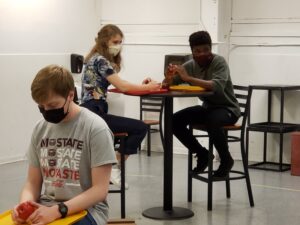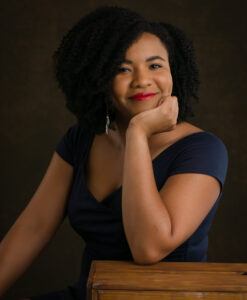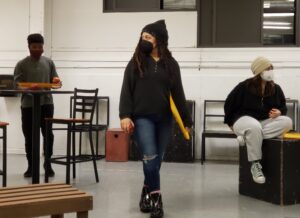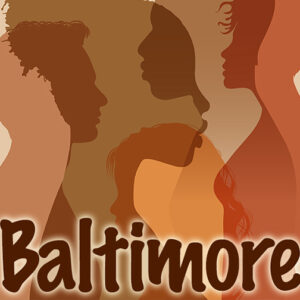“Baltimore touches on many of the prominent issues in today’s society, and allows audiences to see a glance though the eyes of the characters.”
Immediately following the opening of the Mainstage production of Goods Kids is our other repertory show, Baltimore. Written by Kirsten Greenidge and directed by Jon Herbert, Baltimore takes place after a racially-charged incident divides the first-year students of a Resident Advisor, Shelby, and is rooted in a conversation she does not want to have. As pressure to address the controversy mounts from residents, the new dean, and even her best friend, Shelby must decide if she will enter the fray or watch her community come apart at the seams. Although sharp, funny, and searing, Baltimore is ultimately a drama about racism on college campuses.
Let’s take a look at some behind-the-scene interviews with the show’s director, dramaturg, cast, and technical members.

To start, Director Jon Herbert gave us his insight into what the play means to him and how it has been working with our T&D cast and crew. He stated that, “Baltimore is about the very real need to be seen, truly seen. Because we live in a culture (in)formed by white supremacy, people of color suffer identity erasure, either by way of stereotyping or by way of so-called ‘color-blindness.’ Many of the words and actions of the play hit very close to home for the actors, and this has had an intense, visceral effect on them. This process has required an immense amount of bravery, trust and patience. It is scary, and it is exhausting. But, it’s beautiful, and I’m honored to work with this group of sensitive and courageous priests of the stage. I am also proud of the Missouri State Department of Theatre and Dance for choosing this play and giving the many BFA Acting students of color this incredible opportunity to be seen as themselves in the roles they are playing.”
When asked what he hoped or thought audiences might take away from this project, Jon shared, “I hope that the audience, first of all, is entertained. This play is ultimately very heavy, but it’s also very funny and moving and ultimately, I think, optimistic. I also hope that the audience will be challenged to think about (or re-think) what it means to truly see someone, and how even when we mean well, how we might be contributing to the erasure of their identity. I hope that people will think about (or re-think) ideas about color-blindness and false notions of post-racialism. And then, as with any production, I just hope that audiences will leave the performance just a bit more of a sensitive and understanding human being.”

As you can imagine, tackling these themes and understanding their full depth is not easy. Fortunately, dramaturg Aleah Vassell was brought in to help on the production and give our students the societal and historical context they needed. Many shows, though, do not require a dramaturg, so we asked Aleah to explain what it is they do and why someone in this position is so important. They stated that “Dramaturgs can do many things. For Baltimore, my role was to research the play historically, culturally, and politically. Some information found and presented included the playwright and her life, an in-depth look at the idea of race and how it came to be, stereotypes and their history, campus hate crimes, the racial and political climate Baltimore was created during, and more. My work helps the cast and creative team have a deeper understanding of the show. Baltimore can be an intense play, so by offering history and breaking down ideas, I wanted the cast to gain some familiarity and a sense of comfortability with the material being handled. A lot of the info I shared hadn’t been heard of before and led to invigorating conversations about the play, the characters, and also it relates to the actors’ lives outside of the work. Since Baltimore is a show about identity and experience, it was a great feeling to validate the actors’ identity and experiences both in and outside of the play by the research presented.”

Finally, we spoke with cast member Jada Bunch and Properties Designer Amberlynn “Am” Lewis to get their perspectives into the realistic characters and technological aspects of the show. Jada, playing lead Shelby, started by saying “Shelby is a frantic perfectionist. She is dependent on those around her because she doesn’t always trust herself and is so swallowed by her own thoughts and worries, but underneath it all she has a big heart and cares deeply. Shelby does not have a good relationship with her residents because she is never there when they need her, and that escalates after the racist incident.” When asked why audiences should come see the show, she said “because of how relatable and educational it is. Most people of color have had to deal with or knows someone who has had to deal with similar situations. Although this show is pretty heavy, there are some hilarious moments as well.” Am followed by saying that “Technology plays a huge role in how the conversation surrounding the inciting incident of the show develops, and it was important that the props reiterate this fact. For that reason, and thanks to several generous donations from T&D faculty and students, the phones used in the show are real. They vibrate and light up with edited photos on the screen that reflect the world of the play. It’s a subtle detail, and I’m not sure anyone in the audience will notice it, but I really wanted to challenge myself artistically with this project. And, well, they’ve been a challenge!”
It sounds like everyone involved in this show is so genuinely excited to put it in front of an audience and show all the hard work that has been accomplished!
Baltimore opens and runs with 7:30pm performances on February 28, March 1, March 4, and March 7. It also has a 2:30pm matinee on Sunday, March 6. All performances will be located in Craig Halls’ Balcony Theatre. This is a show you won’t want to miss! PURCHASE YOUR TICKETS HERE!

